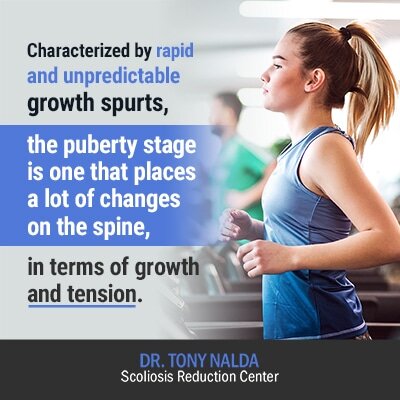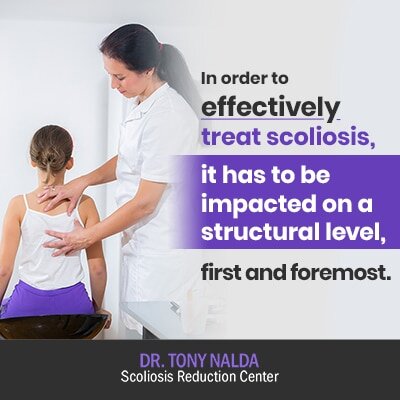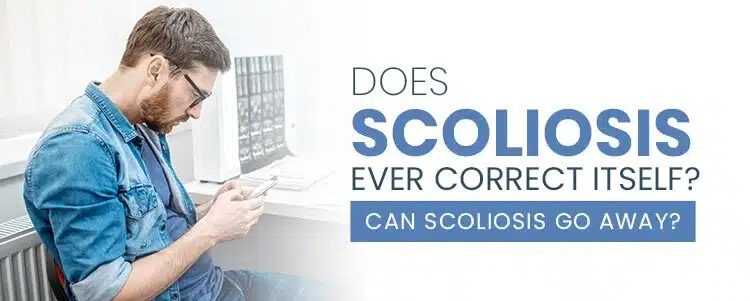When giving a scoliosis diagnosis, a common question I’m asked is if it’s curable, or if it’s possible that it could go away on its own. As scoliosis is an incurable and progressive condition, it will neither go away, nor fix itself without treatment. Although this is difficult to hear, I point out that despite these negatives, it most certainly is treatable.
Before we get into the choices a person has to make when they receive a scoliosis diagnosis, in terms of treatment approach, let’s first spend some time exploring the nature of the condition itself.
What Makes Scoliosis Scoliosis?
As the leading cause of spinal deformity amongst school-aged children in the United States, most people have at least heard of scoliosis. While the average person likely knows it involves the spine, not everyone understands the condition characteristics that deem it a true scoliosis.
Abnormal Spinal Curvature
Scoliosis is an abnormal spinal curvature. The spine has three main natural and healthy curvatures characteristic of the upper, middle, and lower back. These curves work together to give the spine its strength and flexibility.
In a person with scoliosis, there is a loss of these healthy curves as the spine bends to the side and disrupts the biomechanics of the entire spine.
In order for an abnormal spinal curvature to receive an official diagnosis, two condition characteristics have to be present: a certain degree of curvature and rotation.
Scoliosis Degree of Curvature
One of the things that makes scoliosis so interesting is how much it can vary from patient to patient.
For a person to receive an official diagnosis of scoliosis, their abnormal curvature has to reach 10+ degrees. This is determined via X-ray and involves a measurement of the curvature, using the most tilted vertebrae. The degree to which the spine deviates from a straight alignment is the patient’s Cobb angle.
If the curvature measures at 10+ degrees, the first benchmark is hit for reaching a scoliosis diagnosis.
This measurement also places the condition on its severity scale:
- Mild scoliosis: Cobb angle measurement of more than 10 degrees, but less than 25
- Moderate scoliosis: Cobb angle measurement of 25 to 40 degrees
- Severe scoliosis: Cobb angle measurement of 40+ degrees
Rotation
In addition to a Cobb angle measurement of 10+ degrees, the abnormal curvature has to coincide with rotation.
The rotation that occurs alongside an abnormal spinal curvature makes scoliosis a 3-dimensional condition, which is why any effective treatment plan has to address it as such.
So a true scoliosis is described as a lateral (side to side) and rotational (twisting) spinal deformity.
As the condition’s most common form is adolescent idiopathic scoliosis (AIS), for the purposes of this article, we will focus on this form.
Adolescent Idiopathic Scoliosis and Progression

The big challenge to treating scoliosis is trying to stay ahead of the condition’s nature to progress (get worse over time). The reason why AIS is the condition’s most common form is because growth is the biggest known trigger for progression.
Adolescents most commonly diagnosed, between the ages of 10 and 18, are entering into an extreme stage of growth and development. Characterized by rapid and unpredictable growth spurts, the puberty stage is one that places a lot of changes on the spine, in terms of growth and tension.
This is why, with a functional approach, like the one we offer at the Scoliosis Reduction Center®, treatment needs to be started as close to the time of diagnosis as possible. We want to get ahead, and stay ahead, of the condition’s nature to progress with time and growth.
While monitoring is an important part of our treatment approach, both in terms of observing progressive patterns and how the spine is responding to treatment, there is another dominant treatment approach for which monitoring is the main component of treatment.
Watching and Waiting
At the point when a person is diagnosed with scoliosis, they have an important decision to make; it’s the choice of which treatment approach to follow. This is likely the most important scoliosis-related choice they will make, as it guides the patient’s experience with the condition throughout treatment and helps determine treatment results.
I mentioned that the approach we deliver at the Center is termed ‘functional’, there is another dominant treatment approach that’s been in place for many years, and this is known as the ‘traditional’ approach.
The main issue I have with the traditional approach is its passivity. When a person is diagnosed with scoliosis, treatment should be started immediately; otherwise, valuable treatment time is being wasted while someone’s scoliosis is left to progress unimpeded.
For a person walking the traditional route, at the time of diagnosis, if their condition is in the mild or moderate stage, they would likely be told to come back in 3, 6, or 12 months (depending on age and severity) for a follow-up X-ray to see if their condition has progressed; this approach is best described as ‘watching and waiting’.
Basically, while a patient’s condition is in the milder stage, they are told that it should simply be observed, and when/if it progresses, the potential active form of treatment might be the prescription of a Boston brace.
Although the most commonly-used traditional brace used for treating scoliosis in the United States, I believe it represents a big flaw with the traditional approach as a whole. The Boston brace isn’t used to try and ‘correct’ the scoliosis at a structural level; instead, it’s used to try and stop/slow down progression.
The Boston brace is merely addressing one aspect of scoliosis (progression) and not the underlying cause of the condition itself, which is structural. In addition, the Boston brace has to be worn all the time (18-24 hours a day), is cumbersome, uncomfortable, and compliance is a huge issue.
If a patient has followed the traditional-treatment approach recommendations, they have been watching their condition progress until it reached a surgical level and were likely told, “Well, since your condition has progressed from mild to moderate, it’s likely it will continue progressing, so let’s try and stop that progression with a Boston brace.”
If the Boston brace is unsuccessful at stopping progression, they have not yet engaged in any form of active treatment that actually focuses on achieving a structural change, and what often happens after that is the patient is funneled towards spinal-fusion surgery because their curve has now reached surgical level.
Fortunately, there is another proactive approach that I am proud to have cultivated over the years: the functional approach.
The Functional Treatment Approach
Also known as the ‘conservative’ approach or an ‘alternative’ approach, the functional approach treats scoliosis very differently.

We don’t want our patients to have to face the dubious outcomes of invasive medications, injections, and spinal-fusion surgery. Our approach is proactive; we start treatment as soon as possible because I understand the nature of the condition, and virtually every condition, if left untreated, is going to get worse.
In order to effectively treat scoliosis, it has to be impacted on a structural level, first and foremost. Watching and waiting is counterintuitive to me; why watch and wait while a progressive condition, that is virtually guaranteed to get worse, progresses, only to then say, “Now your condition is severe and needs spinal-fusion surgery.”
Here at the Center, our primary goal is both proactive and preventative. First, we combine multiple scoliosis-specific disciplines to customize a treatment plan: chiropractic adjustments, therapy, rehabilitation, and corrective bracing. We do all this to impact the patient’s scoliosis on a structural level, thus preventing the need for surgery by never letting the curvature reach surgical level.
Monitoring is part of our treatment, but more so because it guides our active attempts at reducing the patient’s abnormal curvature on a structural level. We want to see how the spine responds to growth and treatment. We respond to our observations, and X-ray results, by tweaking our treatment plan and apportioning the different disciplines accordingly, in response to the individual needs of our patient and their condition.
I know scoliosis and have devoted my life to providing patients with a better treatment option than what the traditional approach offers. Spinal fusion is an invasive surgery that comes at the price of mobility, has a high risk of complications/side effects, and is lacking data on its long-term effects.
When patients ask me if their scoliosis can go away, fix itself, or get better, I have to be clear that it can most certainly improve with active treatment, but without active treatment, or with treatment that funnels them towards surgery, their scoliosis experience, and life, can be altered significantly.
Conclusion
So does scoliosis ever correct itself? In the vast majority of cases, and especially those that enter into the moderate and severe stages: no, it’s very unlikely that a person’s scoliosis will simply resolve itself.
The more relevant question then becomes, “What can I do to prevent my scoliosis from getting worse?” The answer is to address the true progressive nature of the condition by engaging in active treatment that also addresses the underlying structural nature of the condition. By doing this, you can work towards achieving a curvature reduction, supporting and stabilizing the spine, and avoiding the need for spinal-fusion surgery.
The longer a condition is left to progress and the more severe it becomes, the more likely it is that the person will develop more severe symptoms, such as lung impairment, pain, and mobility issues.
Once a person undergoes spinal-fusion surgery, the results are permanent, and they are not always positive. Why not try a more natural and functional approach that has the potential to reduce, or eliminate, those scoliosis-related complications?
Here at the Scoliosis Reduction Center®, I’m proud to be able to offer my patients the benefits of a functional treatment approach that enables them to improve their condition and lessen related symptoms.





